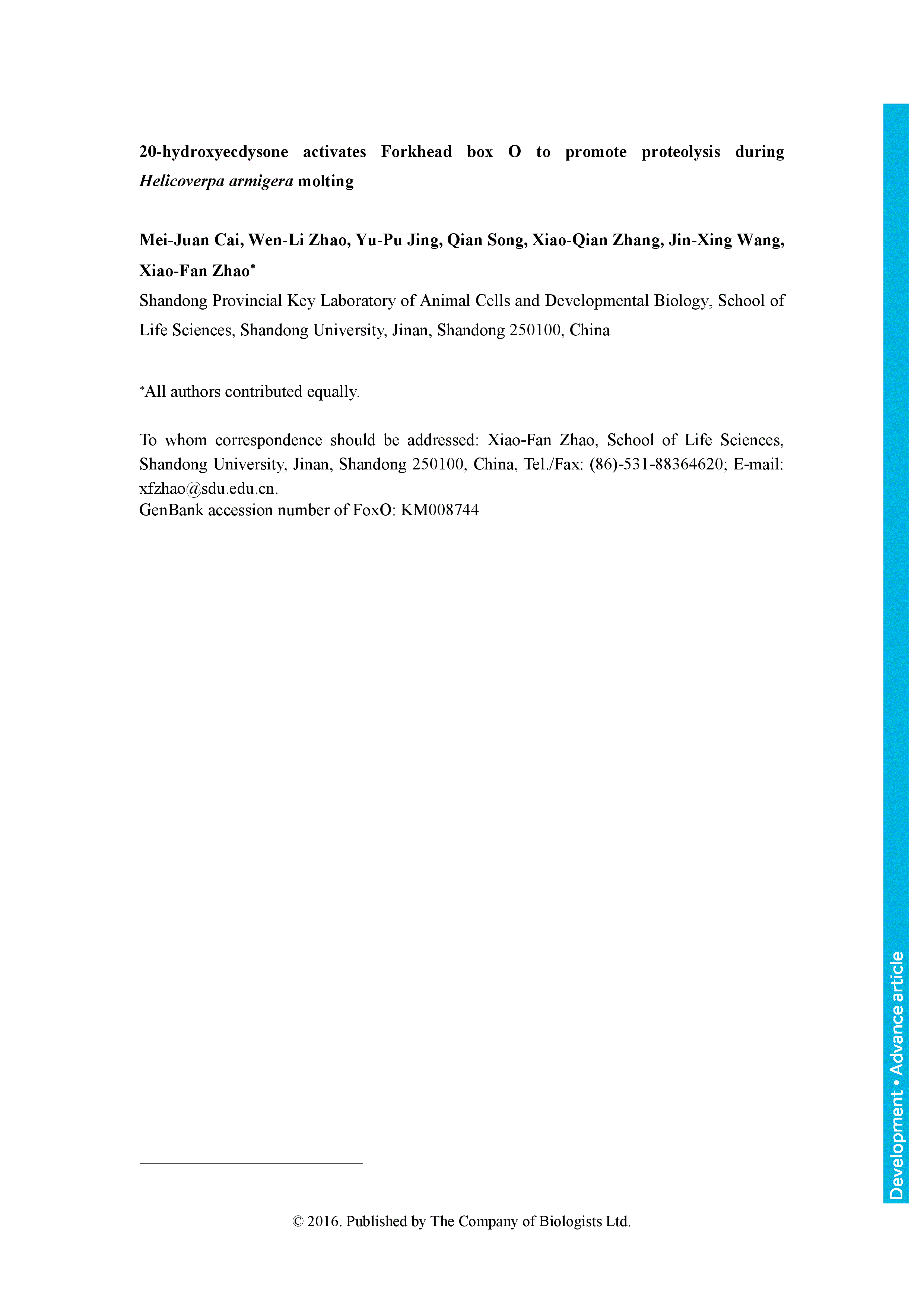Insulin inhibits transcription factor forkhead box O (FoxO) activity, and the steroid hormone 20-hydroxyecdysone (20E) activates FoxO; however, the mechanism is unclear. We hypothesized that 20E upregulates phosphatidylinositol-3,4,5-trisphosphate 3-phosphatase (PTEN) expression to activate FoxO, thereby promoting proteolysis during molting in the lepidopteran insect Helicoverpa armigera. FoxO expression is increased during molting and metamorphosis. The knockdown of FoxO in fifth instar larvae results in larval molting failure. 20E induces FoxO non-phosphorylation and nuclear translocation. Insulin, via Akt, induces FoxO phosphorylation and cytoplasm localization. 20E represses insulin-induced Akt phosphorylation and FoxO phosphorylation. 20E, via ecdysone receptor B1 (EcRB1) and the ultraspiracle protein (USP1), upregulates PTEN expression, which represses Akt phosphorylation, thereby repressing FoxO phosphorylation. The non-phosphorylated FoxO enters the nucleus and attaches to a FoxO binding element in the upstream region of the Broad isoform 7 (BrZ7) gene to regulate BrZ7 transcription under 20E induction. 20E upregulates FoxO expression via EcRB1 and USP1. FoxO regulation of BrZ7 expression regulates CarboxypeptidaseA expression for final proteolysis during insect molting. Hence, 20E activates FoxO via upregulating PTEN expression to counteract insulin activity and promote proteolysis.
20-hydroxyecdysone activates Forkhead box O to promote proteolysis during Helicoverpa armigera molting
Currently Viewing Accepted Manuscript - Newer Version Available
Mei-Juan Cai, Wen-Li Zhao, Yu-Pu Jing, Qian Song, Xiao-Qian Zhang, Jin-Xing Wang, Xiao-Fan Zhao; 20-hydroxyecdysone activates Forkhead box O to promote proteolysis during Helicoverpa armigera molting. Development 2016; dev.128694. doi: https://doi.org/10.1242/dev.128694
Download citation file:
Advertisement
Call for papers: Uncovering Developmental Diversity

Development invites you to submit your latest research to our upcoming special issue: Uncovering Developmental Diversity. This issue will be coordinated by our academic Editor Cassandra Extavour (Harvard University, USA) alongside two Guest Editors: Liam Dolan (Gregor Mendel Institute of Molecular Plant Biology, Austria) and Karen Sears (University of California Los Angeles, USA).
Choose Development in 2024

In this Editorial, Development Editor-in-Chief James Briscoe and Executive Editor Katherine Brown explain how you support your community by publishing in Development and how the journal champions serious science, community connections and progressive publishing.
Journal Meeting: From Stem Cells to Human Development

Register now for the 2024 Development Journal Meeting From Stem Cells to Human Development. Early-bird registration deadline: 3 May. Abstract submission deadline: 21 June.
Pluripotency of a founding field: rebranding developmental biology

This collaborative Perspective, the result of a workshop held in 2023, proposes a set of community actions to increase the visibility of the developmental biology field. The authors make recommendations for new funding streams, frameworks for collaborations and mechanisms by which members of the community can promote themselves and their research.
Read & Publish Open Access publishing: what authors say

We have had great feedback from authors who have benefitted from our Read & Publish agreement with their institution and have been able to publish Open Access with us without paying an APC. Read what they had to say.



